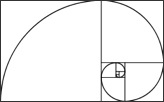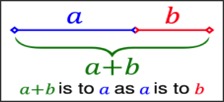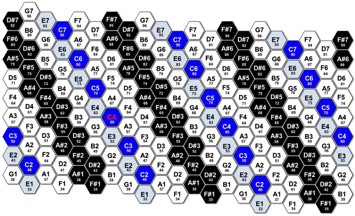Microtonality
WHAT THE HECK IS MICROTONALITY?
Simply put, microtonality is music that contains more, or less, than the usual 12 notes per octave. I prefer to use only equal tempered tunings, meaning that each step in the scale is the same musical interval.
After hearing 12 tone music for so many years, it can be quite refreshing (or torturous, depending on the person) to be immersed in a new tonality.
You might want to read Wikipedia: Microtonal Music
WARNING FOR FELLOW MICROTONALISTS
I compose microtonal music strictly by ear and leave it to others to analyze, so you won’t find ratios or mathematics here. I reserve my left brain for building keyboards and chaos music. ;-)
BACKGROUND
When performing microtonal music with my band ZIA over the years, the reaction of our general audience is usually the same. They don’t realize it’s microtonal, nor do they necessarily know what "microtonal" means. Rather, they might notice that the music has a different "flavor" -- and it’s not vanilla.
I was introduced to the idea of microtonal music in 1990 at Berklee College of Music in Boston, when one fine day in Electronic Music Composition class, Dr. Richard Boulanger surprised us by performing and singing his piece, Solemn Song for Evening, which he composed in the Bohlen-Pierce Scale. My hair stood on end as the alien notes washed over me. The notes were from outer space, yet it was still music. Wonderful music!
From then onward I was dedicated to writing microtonal music. One of my earliest pieces was Stick Men, also in the Bohlen-Pierce Scale.
I had the pleasure of watching Dr Boulanger perform Solemn Song again, 20 years later, at the first Bohlen-Pierce Symposium in Boston. He performs it on the Radio Baton, invented by Max Mathews.
I performed Stick Men and a newer piece called Love Song, at the same symposium, with Dr Boulanger on the sonome (the hexagon keyboard invented by Peter Davies) rearranged for the Bohlen-Pierce Scale. I built the other two keyboards especially for this performance. The one I’m playing is a “Vertical Keyboard”, arranged for Bohlen-Pierce, in Dur II mode. I call it the “BP-tar”. The other keyboard, which Dan Sedgewick is playing, is a Korg Poly-800 rearranged for Bohlen-Pierce, in Lambda mode. Dan’s wife, Marji Gere, is playing a BP-tuned violin. It was humbling being on stage with such talented performers, and the only one without a doctorate.
Here is the entire Bohlen-Pierce Symposium playlist, including lectures by myself, Dr B, Max Mathews and Heinz Bohlen as well as various performances.
In 2000, while at NYU, I wrote a research paper on the Bohlen-Pierce Scale. I’m currently developing hexagonal keyboard layouts for different equal temperaments, building custom Vertical Piano keyboards (for sale!), and composing.
I stay in touch with other microtonalists through the Xenharmonic Alliance.
MY FAVORITE TUNINGS
Below are some music samples in my three favorite tunings, plus hexagon and piano-style keyboards that I’ve developed for each tuning. As you listen, see how long it takes for your ears to “tune-in”. Does each tuning sound like a different “flavor”? I would love to hear your feedback.
THE BOHLEN-PIERCE SCALE
My official Bohlen-Pierce Scale page
listen -----> Love Song (2007, Elaine Walker) | Love Song (2008, live performance by 17 Tone Piano Project. Thanks guys!) | Stick Men (1992, ZIA, v1.5 CD) | I Know of No Geometry (Dr. Richard Boulanger) | Bohlen-Pierce Minus 1 (Carlo Serafini) | More!
My official Bohlen-Pierce Scale page
listen -----> Love Song (2007, Elaine Walker) | Love Song (2008, live performance by 17 Tone Piano Project. Thanks guys!) | Stick Men (1992, ZIA, v1.5 CD) | I Know of No Geometry (Dr. Richard Boulanger) | Bohlen-Pierce Minus 1 (Carlo Serafini) | More!
C-Thru Music lent me one of their sonome keyboards, called the AXIS, for a few months, and I rearranged the keys for the Bohlen-Pierce Scale. This particular AXIS toured with the Lionel Richie Band on loan, went to me, and then it went to my former professor, Dr. Boulanger, in the Synthesis Department of Berklee College of Music. I now have another one and am experimenting with layouts and chords for other tunings.
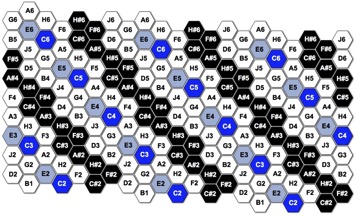

Lambda is most people’s BP mode of choice, and the keyboards look very tidy.

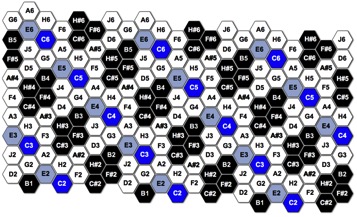

Swap the last two black/white keys to get Dur II mode. It’s easier to see, and play.
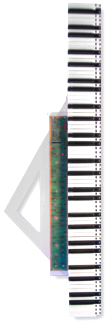
19 NOTES PER OCTAVE
LISTEN: Golden (2000, ZIA, Big Bang CD) | Resolution (2000, ZIA, Big Bang CD) | Hand Held (1995, ZIA, SHEM CD) | Cover of Madonna's Vogue (1993, D.D.T., Discomedia)
You might want to read: Wikipedia 19tet
LISTEN: Golden (2000, ZIA, Big Bang CD) | Resolution (2000, ZIA, Big Bang CD) | Hand Held (1995, ZIA, SHEM CD) | Cover of Madonna's Vogue (1993, D.D.T., Discomedia)
You might want to read: Wikipedia 19tet
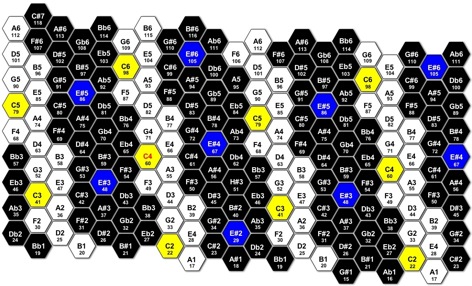

17 NOTES PER OCTAVE
LISTEN: The Beginning (2012, ZIA, Drum N Space) | 17 Tone Piano Project (mostly 17 tone music, and other tunings as well)
LISTEN: The Beginning (2012, ZIA, Drum N Space) | 17 Tone Piano Project (mostly 17 tone music, and other tunings as well)


THE GOLDEN RATIO TUNING
LISTEN: Humans and Martian Machines (2000, Elaine Walker, MARS CD)
The Golden Ratio Tuning was the result of a school assignment in Composition class at NYU, which I had in 2000 during my Masters studies in Music Technology. The assignment was simply to write a piece of music utilizing the Golden Ratio in some way. This is the only unequal temperament I have ever used, and for that matter, I only wrote one piece with it!
LISTEN: Humans and Martian Machines (2000, Elaine Walker, MARS CD)
The Golden Ratio Tuning was the result of a school assignment in Composition class at NYU, which I had in 2000 during my Masters studies in Music Technology. The assignment was simply to write a piece of music utilizing the Golden Ratio in some way. This is the only unequal temperament I have ever used, and for that matter, I only wrote one piece with it!
